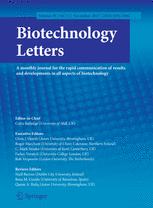Ver ítem
- xmlui.general.dspace_homeCentros Regionales y EEAsCentro Regional Mendoza - San JuanEEA MendozaArtículos científicosxmlui.ArtifactBrowser.ItemViewer.trail
- Inicio
- Centros Regionales y EEAs
- Centro Regional Mendoza - San Juan
- EEA Mendoza
- Artículos científicos
- Ver ítem
Characterization of the phenolic fraction from Argentine wine and its effect on viability and polysaccharide production of Pediococcus pentosaceus
Resumen
Objectives: To qualitatively and quantitatively characterize a low molecular weight phenolic fraction (LMF) of Malbec wine from Cafayate, Argentina, and evaluate its effect on viability and exopolysaccharide production of Pediococcus pentosaceus 12p, a wine spoilage bacterium. Results: The phenolic compounds detected were, in general, comparable to data previously reported but hydroxycinnamic acids were detected at higher concentrations than determined in
[ver mas...]
Objectives: To qualitatively and quantitatively characterize a low molecular weight phenolic fraction (LMF) of Malbec wine from Cafayate, Argentina, and evaluate its effect on viability and exopolysaccharide production of Pediococcus pentosaceus 12p, a wine spoilage bacterium. Results: The phenolic compounds detected were, in general, comparable to data previously reported but hydroxycinnamic acids were detected at higher concentrations than determined in other studies. Addition of LMF at identical concentrations present in wine or a four times concentrated LMF mixture to a synthetic wine-like medium produced a diminution in bacterial viability and exopolysaccharide production in the supernatant culture. Transmission electron microscopy revealed damage of bacterial cell integrity after 96 h of incubation only in the presence of four times concentrated LMF. Conclusion: This is the first time a low molecular weight phenolic fraction has been characterized in Cafayate wine and it has demonstrated a marked antimicrobial effect on an exopolysaccharide-producing wine spoilage bacterium.
[Cerrar]

Autor
Stivala, Maria Gilda;
Villeco, Margarita Beatriz;
Fanzone, Martín Leandro;
Jofre, Viviana Patricia;
Aredes Fernandez, Pedro Adrian;
Fuente
Biotechnology letters 37 (12) : 2435–2444. (December 2015)
Fecha
2015-12
ISSN
0141-5492 (Print)
1573-6776 (Online)
1573-6776 (Online)
Formato
pdf
Tipo de documento
artículo
Palabras Claves
Derechos de acceso
Restringido
 Excepto donde se diga explicitamente, este item se publica bajo la siguiente descripción: Creative Commons Attribution-NonCommercial-ShareAlike 2.5 Unported (CC BY-NC-SA 2.5)
Excepto donde se diga explicitamente, este item se publica bajo la siguiente descripción: Creative Commons Attribution-NonCommercial-ShareAlike 2.5 Unported (CC BY-NC-SA 2.5)

